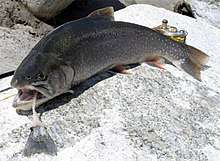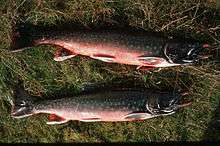Arctic char
The Arctic char or Arctic charr (Salvelinus alpinus) is a cold-water fish in the family Salmonidae, native to alpine lakes and arctic and subarctic coastal waters. Its distribution is circumpolar. It spawns in fresh water and populations can be lacustrine, riverine or anadromous, where they return from the ocean to their fresh water birth rivers to spawn.[3] No other freshwater fish is found as far north; it is, for instance, the only fish species in Lake Hazen on Ellesmere Island in the Canadian Arctic. It is one of the rarest fish species in Britain and Ireland, found mainly in deep, cold, glacial lakes, and is at risk from acidification. In other parts of its range, such as the Nordic countries, it is much more common, and is fished extensively. In Siberia, it is known as golets (Russian: голец) and it has been introduced in lakes where it sometimes threatens less hardy endemic species, such as the small-mouth char and the long-finned char in Elgygytgyn Lake.
| Arctic char | |
|---|---|
 | |
| Scientific classification | |
| Kingdom: | Animalia |
| Phylum: | Chordata |
| Class: | Actinopterygii |
| Order: | Salmoniformes |
| Family: | Salmonidae |
| Genus: | Salvelinus |
| Species: | S. alpinus |
| Binomial name | |
| Salvelinus alpinus | |
| Synonyms[2] | |
|
previous scientific names
| |
The Arctic char is closely related to both salmon and lake trout, and has many characteristics of both. The fish is highly variable in colour, depending on the time of year and the environmental conditions of the lake where it lives. Individual fish can weigh 20 lb (9.1 kg) or more with record-sized fish having been taken by anglers in northern Canada, where it is known as iqaluk or tariungmiutaq in Inuktitut. Generally, whole market-sized fish are between 2 and 5 lb (0.91 and 2.27 kg). The flesh colour can range from a bright red to a pale pink.
Taxonomy
Name
The arctic char was initially scientifically described in the salmon genus Salmo as Salmo alpinus by Carl Linnaeus in the 1758 edition of Systema Naturae, which is the work that established the system of binomial nomenclature for animals.[4] Meanwhile, he described Salmo salvelinus and Salmo umbla, which were later considered as synonyms of S. alpinus. John Richardson (1836) separated them into a subgenus Salmo (Salvelinus), which now is treated as a full genus.[5] The genus name Salvelinus is from German "Saibling" – little salmon.[6]
The English name is thought to derive from Old Irish ceara/cera meaning "[blood] red",[7] referring to its pink-red underside.[8][9] This would also connect with its Welsh name torgoch, "red belly".[10]
Subspecies in North America
In North America, three subspecies of Salvelinus alpinus have been recognized.[11] "S. a. erythrinus" is native to almost all of Canada's northern coast. This subspecies is nearly always anadromous. S. a. oquassa, known as the blueback trout or Sunapee trout, is native to eastern Quebec and northern New England, although it has been extirpated from most of its eastern United States range. S. a. oquassa is never anadromous. Dwarf Arctic char has been classified as S. a. taranetzi. These scientific names are not generally accepted, however, as the names S. a. erythrinus and S. a. taranetzi usually refer to subspecies that are endemic to Siberia only.
Arctic char are also found in Lake Pingualuit in the Ungava Peninsula, Quebec, a lake situated in an impact crater formed roughly 1.4 million years ago. Since the last glaciation, changing water levels are believed to have connected the lake with glacial runoff and surrounding streams and rivers, allowing char to swim upstream into the lake. Arctic char are the only fish found in the lake, and signs of fish cannibalism have been found.[12]
Morphs

Arctic char are notable for exhibiting numerous, seemingly distinct morphological variants or 'morphs' throughout the range of the species.[13][14][15][16][17] Consequently, Arctic charr have been referred to as the 'most variable vertebrate on Earth'.[15] These morphs are often sympatric within lakes or rivers.[13][14][16][17] Morphs often vary significantly in size, shape and colour.[13][14][16][17] Morphs often demonstrate differences in migratory behaviour, being resident or anadromous fish, and in feeding behaviour and niche placement.[14][16][17] Morphs often interbreed, but they can also be reproductively isolated and represent genetically distinct populations,[17] which have been cited as examples of incipient speciation.[14]
In Iceland, Þingvallavatn is noted for the evolution of four morphs: small benthic, large benthic, small limnetic and large limnetic.[13][18]
In Svalbard, Norway, Lake Linne´vatn on Spitsbergen has dwarf, 'normal', and normal-sized anadromous fish, and Lake Ellasjøen on Bear Island has a dwarf, small littoral and large pelagic morph.[17]
In Sweden three morphs are usually recognised: storröding, större fjällröding and mindre fjällröding.[19] Wherever these types occur together in the same lake storröding is the largest.[19] Contrary to what the name may suggest when större fjällröding and mindre fjällröding are found together mindre fjällröding tend to be the largest morph.[19] Even within storröding morphs can be found; for example the Sommen charr of Lake Sommen tend to grow faster and reach sexual maturity later the charr from Lake Vättern.[20][21]
Spawning
Spawning takes place from September to November over rocky shoals in lakes with heavy wave action and in slower gravel-bottom pools in rivers. As with most salmonids, vast differences in coloration and body shape occur between sexually mature males and females. Males develop hooked jaws known as kypes and take on a brilliant red colour. Females remain fairly silver. Most males set up and guard territories and often spawn with several females. The female constructs the nest, or redd. A female anadromous char usually deposits from 3,000 to 5,000 eggs. Char do not die after spawning like Pacific salmon and often spawn several times throughout their lives, typically every second or third year. Young char emerge from the gravel in spring and stay in the river from 5 to 7 months or until they are about 6–8 in (15–20 cm) in length.
- A juvenile arctic char
Diet
The char diet varies with the seasons. During late spring and summer, they feed on insects found on the water's surface, salmon eggs, snails and other smaller crustaceans found on the lake bottom, and smaller fish up to a third of the char's size. During the autumn and winter months the char feeds on zooplankton and freshwater shrimps that are suspended in the lake and also occasionally feeds on smaller fish.
Farming

Research aimed at determining the suitability of Arctic char as a cultured species has been going on since the late 1970s. The Canadian government's Freshwater Institute of Fisheries and Oceans Canada at Winnipeg, Manitoba, and the Huntsman Marine Science Centre of New Brunswick, pioneered the early efforts in Canada. Arctic char are also farmed in Iceland, Estonia, Norway, Sweden, Finland, West Virginia,[22] and Ireland.
Arctic char were first investigated because they were expected to have low optimum temperature requirements and would grow well at the cold water temperatures present in numerous areas of Canada. They could be an alternate species to rainbow trout and could provide producers with a different niche in the marketplace. The initial research efforts concentrated on identifying the culture needs and performance characteristics of the species. The Freshwater Institute was responsible for distributing small numbers of char eggs to producers in Canada; these producers in return helped determine the suitability of char in a commercial setting. Commercial char breeding stocks have now been developed largely from these sources.
In 2006, Monterey Bay Aquarium Seafood Watch[23] program added farmed Arctic char as an environmentally sustainable Best Choice for consumers, stating: "Arctic char use only a moderate amount of marine resources for feed. In addition, Arctic char are farmed in land-based, closed systems that minimize the risk of escape into the wild."[24]
As food

Commercial Arctic char typically weigh between 2 and 10 lb (1 and 4.5 kg). The flesh is fine flaked and medium firm. The colour is between light pink and deep red, and the taste is like something between trout and salmon.[25]
References
- Freyhof, J. & Kottelat, M. (2008). "Salvelinus alpinus". IUCN Red List of Threatened Species. 2008: e.T19877A9102572. doi:10.2305/IUCN.UK.2008.RLTS.T19877A9102572.en.
- "Synonyms of Salvelinus alpinus (Linnaeus, 1758)". Fishbase. Retrieved 9 December 2016.
- "Cambridge Bay Arctic Char" (PDF). Fisheries and Oceans Canada. Archived from the original (PDF) on 12 December 2011.
- alpinus, Salmo in Catalog of Fishes (2016)
- Salvelinus in Catalog of Fishes (2016)
- Froese, Rainer and Pauly, Daniel, eds. (2016). "Salvelinus alpinus" in FishBase. December 2016 version.
- edil@qub.ac.uk. "eDIL - Irish Language Dictionary". edil.qub.ac.uk.
- Skeat, Walter W. (15 February 2013). An Etymological Dictionary of the English Language. Courier Corporation. ISBN 9780486317656 – via Google Books.
- Various. Chambers's Twentieth Century Dictionary (part 1 of 4: A-D). Library of Alexandria. ISBN 9781465562883 – via Google Books.
- Weekley, Ernest (5 March 2013). An Etymological Dictionary of Modern English. Courier Corporation. ISBN 9780486122878 – via Google Books.
- Behnke, Robert J. (2002). "Arctic Char Salvelinus alpinus". Trout and Salmon of North America. Tomelleri, Joseph R. (illustrator). The Free Press. pp. 303–311. ISBN 0-7432-2220-2.
- E. A. Keller; R. H. Blodgett & J. J. Clague (2010). The Catastrophic Earth, Natural Disasters. Pearson Custom Publishing. ISBN 9780536878137.
- Malmquist, H. J., Snorrason, S. S., Skulason, S., Jonsson, B., Sandlund, O. T., & Jonasson, P. M. (1992). Diet differentiation in polymorphic Arctic charr in Thingvallavatn, Iceland. Journal of Animal Ecology, 21-35.
- Knudsen, Rune; Klemetsen, Anders; Amundsen, Per-Arne; Hermansen, Bjørn (2006). "Incipient speciation through niche expansion: an example from the Arctic charr in a subarctic lake". Proceedings of the Royal Society B. 273 (1599): 2291–2298. doi:10.1098/rspb.2006.3582. PMC 1636095. PMID 16928630.
- Klemetsen, Anders (2006). "The Most Variable Vertebrate on Earth". Journal of Ichthyology. 273 (10): 781–791. doi:10.1134/S0032945213100044.
- Alekseyev, S.S.; Gordeeva, N.V.; Matveev, A.N.; Samusenok, V.P.; Vokin, A.I.; Yur'rev, A.L. (2014). "Three Sympatric forms of Arctic Charr Salvelinus alpinus Complex (Salmoniformes, Salmonidae) from Lake Kamkanda, Northern Transbaikalia". Journal of Ichthyology. 54 (6): 384–408. doi:10.1134/S0032945214040018.
- O'Malley, Kathleen G.; Vaux, Felix; Black, Andrew N. (2019). "Characterizing neutral and adaptive genomic differentiation in a changing climate: The most northerly freshwater fish as a model". Ecology and Evolution. 9 (4): 2004–2017. doi:10.1002/ece3.4891. PMC 6392408. PMID 30847088.
- http://luvs.hi.is/arctic_charr_development_evolution_and_genetics University of Iceland, Institute of Life and Environmental Sciences: Arctic charr development evolution and genetics (Accessed August 2016)
- Kullander, Sven O.; Delling, Bo (2012). "Salvelinus – rödingar". Nationalnyckeln till Sveriges flora och fauna. Strålfeniga fiskar. Actinopterygii (in Swedish). Uppsala: ArtDatabanken, SLU. pp. 184–186.
- Melin, Daniel & Rydberg, Daniel (2009). Sommenröding: En kartläggning av rödingens lekområden 2006 & 2008 (PDF) (Report). Medelande (in Swedish). Länstyrensen i Jönköpings Län. pp. 1–49. Retrieved 20 April 2019.CS1 maint: uses authors parameter (link)
- Hammar, J. (2014). "Natural resilience in Arctic charr Salvelinus alpinus: life history, spatial and dietary alterations along gradients of interspecific interactions". Fish Biology. 85 (1): 81–118. doi:10.1111/jfb.12321. PMID 24754706.
- ARC | Mining Fresh Water for Aquaculture Archived 21 September 2015 at the Wayback Machine
- "Seafood Watch - Official Site of the Monterey Bay Aquarium's Sustainable Seafood Program". www.seafoodwatch.org.
- Seafood Watch Newsletter, August 2006, Monterey Bay Aquarium, Monterey, California, USA Archived 27 September 2007 at the Wayback Machine
- "Chef's Resources - Arctic Char Profile". Chefs-resources.com.
External links
| Wikimedia Commons has media related to Salvelinus alpinus. |
- Information on farming Arctic char: This site deals with Arctic char and farming the fish using land based farms. Gives a background and description of the species including its aquaculture history.
- Environmental concerns
- Ecology of Freshwater Fish Vol. 16, No. 1—Issue on the International Conference on the Conservation and Management of Arctic Charr
